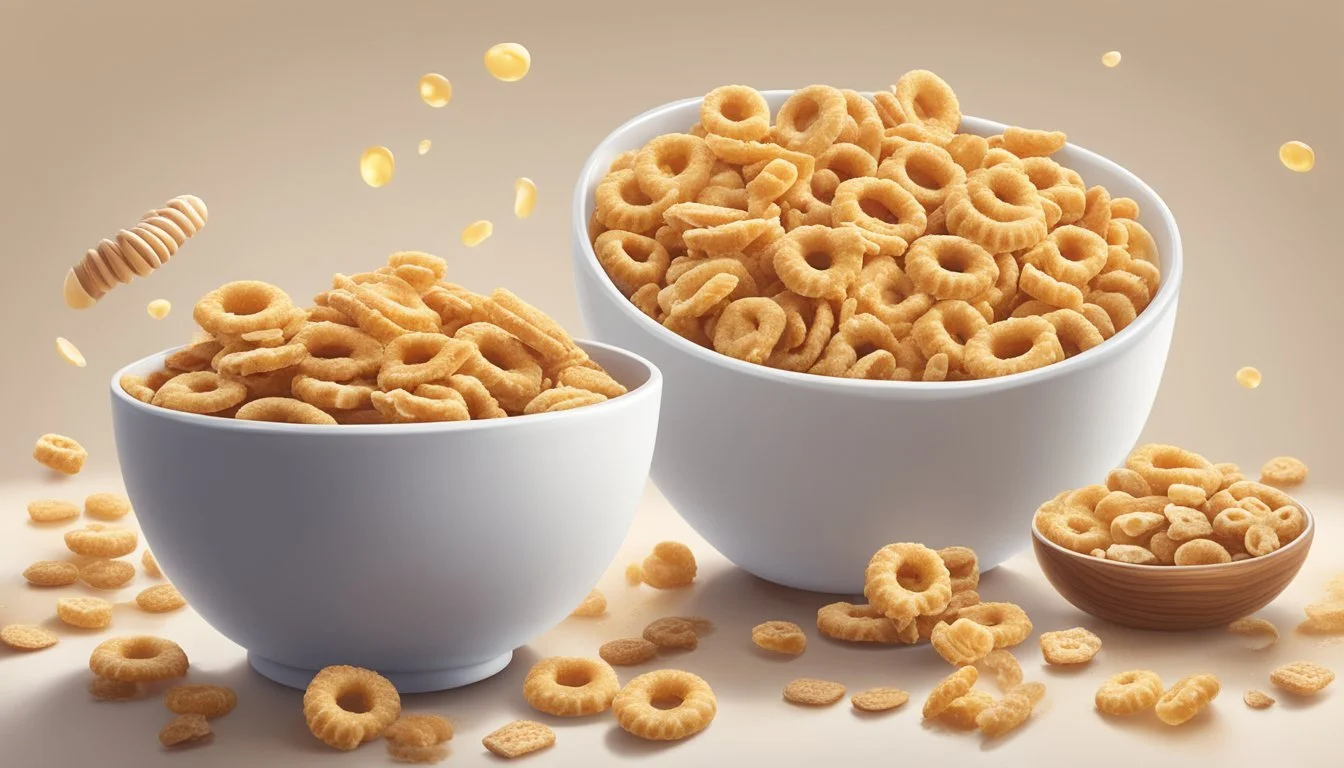Cinnamon Toast Crunch vs Honey Nut Cheerios
Which Breakfast Cereal Reigns Supreme?
This Article is Part of Our Breakfast Cereal Guide with Details on Cinnamon Toast Crunch Nutrition and Honey Nut Cheerios Nutrition
Choosing between Cinnamon Toast Crunch and Honey Nut Cheerios is a common dilemma for cereal lovers in 2024. Each cereal has its unique attributes that cater to different tastes and nutritional needs. Cinnamon Toast Crunch stands out for its sweet and spicy cinnamon flavor, while Honey Nut Cheerios offers a subtler sweetness with a hint of honey and nutty undertones.
When it comes to complex carbohydrates, Cinnamon Toast Crunch provides 13.0 grams per serving, slightly more than the 11.5 grams found in Honey Nut Cheerios. This makes the former a bit more energy-dense, providing a quick boost in the morning. On the other hand, Honey Nut Cheerios tends to be a healthier option overall, with lower calorie and fat content per serving compared to Cinnamon Toast Crunch.
Both cereals have their own appeal, making the choice highly dependent on personal preference and dietary requirements. Whether opting for the delightful crunch of Cinnamon Toast Crunch or the balanced sweetness of Honey Nut Cheerios, cereal enthusiasts have flavorful options to kickstart their day.
Overview of Cereals
Cinnamon Toast Crunch and Honey Nut Cheerios are two popular breakfast cereals with distinct histories and broad market appeal. Both are produced by General Mills, but they cater to different tastes and nutritional preferences.
History and Manufacturers
Cinnamon Toast Crunch was introduced by General Mills in 1984. It quickly gained fame for its unique cinnamon flavor and crunch. The cereal is developed in partnership with key flavor experts to ensure it delivers the perfect blend of cinnamon and sugar.
Honey Nut Cheerios, on the other hand, was introduced earlier, in 1979, also by General Mills. It evolved from the original Cheerios, which was first launched in 1941. Honey Nut Cheerios offers a honey and almond taste, which distinguishes it from the original oat flavor. Both cereals are iconic in the General Mills lineup and have seen various iterations and flavor modifications over the years.
Market Popularity
Cinnamon Toast Crunch remains a favorite among children and adults alike, often promoted for its playful and bold cinnamon taste. It frequently ranks high in consumer preference surveys and has a strong presence in the North American market.
Honey Nut Cheerios benefits from its health-conscious branding, often marketed as heart-healthy due to its whole grain oats and lower sugar content compared to many other cereals. It remains one of the best-selling cereals in the United States, appealing to health-conscious adults and families.
Both cereals maintain significant market shares and are regularly featured in marketing campaigns and cross-promotional efforts by General Mills. Their enduring popularity is a testament to their distinct flavors and appealing nutritional profiles.
Nutritional Profiles
Cinnamon Toast Crunch and Honey Nut Cheerios vary significantly in their nutritional content. Below is an analysis focusing on calories, macronutrients, and the vitamins and minerals present in each cereal.
Calorific Values
Caloric content is a key factor in evaluating the healthiness of breakfast cereals. Cinnamon Toast Crunch provides 130 calories per ¾ cup serving. In comparison, Honey Nut Cheerios offers a slightly higher caloric value, with 140 calories per ¾ cup serving.
Though a difference of 10 calories per serving might seem small, it could add up over time, particularly if the cereal is consumed daily.
Cereal Calories per Serving Cinnamon Toast Crunch 130 Honey Nut Cheerios 140
Macronutrient Content
Cinnamon Toast Crunch contains 3 grams of fat, 25 grams of carbohydrates— of which 9 grams are sugars— and 1 gram of protein per serving. Honey Nut Cheerios, on the other hand, consists of 2 grams of fat, 22 grams of carbohydrates (including 9 grams of sugars), and 3 grams of protein.
The higher protein content in Honey Nut Cheerios may be more suitable for those looking to increase their protein intake. The fiber content is another aspect to consider: Cinnamon Toast Crunch provides 2 grams, while Honey Nut Cheerios offers 2 grams per serving.
Nutrient Cinnamon Toast Crunch Honey Nut Cheerios Fat (g) 3 2 Carbohydrates (g) 25 22 Sugars (g) 9 9 Protein (g) 1 3 Dietary Fiber (g) 2 2
Vitamins and Minerals
When it comes to vitamins and minerals, both cereals are fortified but differ in their nutrient profiles. Cinnamon Toast Crunch offers 11 essential vitamins and minerals, including iron, calcium, and vitamin D. Honey Nut Cheerios also provides a range of vitamins and minerals, such as iron and calcium, and is particularly known for its higher content of potassium, contributing 180 milligrams per serving.
These nutrients play vital roles in maintaining overall health, with iron aiding in oxygen transport in the body and calcium supporting bone health.
Vitamin/Mineral Cinnamon Toast Crunch Honey Nut Cheerios Iron (%) Varies Varies Calcium (%) Varies Varies Vitamin D (%) Provided Provided Potassium (mg) N/A 180
This breakdown highlights the key nutritional differences and similarities between the two cereals.
Health Considerations
When comparing Cinnamon Toast Crunch and Honey Nut Cheerios, important health factors include dietary restrictions and the content of sugar and fat. Each cereal has its own strengths and weaknesses, making them suitable for different individuals.
Dietary Restrictions
Honey Nut Cheerios is often praised for being gluten-free, making it suitable for those with celiac disease or gluten intolerance. In contrast, Cinnamon Toast Crunch is not gluten-free and may not be appropriate for everyone with dietary restrictions.
For individuals prioritizing protein intake, neither cereal offers a significant amount. Each serving contains around 1 gram of protein.
Fiber content is another consideration, with Honey Nut Cheerios slightly edging out with fiber, which can aid in digestion and satiety. Both cereals, however, should be consumed with balanced meals to avoid reliance on them for fiber needs.
Sugar and Fat Evaluation
Sugar content is a critical factor for those monitoring their diet, especially individuals with diabetes. Cinnamon Toast Crunch has a higher sugar content with 9 grams per serving compared to Honey Nut Cheerios.
Fat content is relatively modest in both cereals. Cinnamon Toast Crunch contains about 3 grams of fat per serving, with 0.5 grams being saturated fat. Honey Nut Cheerios has slightly more fat per serving but remains within a reasonable range for most diets.
Considering empty calories, both cereals are less ideal compared to whole foods but remain popular choices due to their taste. Reducing snack-like cereals and incorporating lower-sugar options in regular diet can provide health benefits.
Consumer Preferences
Preferences for Cinnamon Toast Crunch and Honey Nut Cheerios vary greatly among consumers, primarily hinging on taste, texture, and perceived health benefits.
Taste and Texture
Cinnamon Toast Crunch captivates with its sweet and spicy cinnamon flavor.
The crunchy cinnamon squares provide a burst of flavor in every bite, leaving a lingering warmth that many find irresistible. The texture remains crisp in milk, enhancing the overall eating experience.
Honey Nut Cheerios offers a more understated sweetness, complemented by a hint of honey and a nutty undertone.
The cereal has a delicate, satisfying crunch and maintains its integrity in milk. This combination of flavors and textures appeals to those who prefer a more subtle taste profile.
Consumer Ratings
Cinnamon Toast Crunch generally receives high ratings for its bold flavor and satisfying crunch.
Many consumers appreciate its balance of sweetness and spice, making it a popular choice for both adults and children.
Honey Nut Cheerios also garners strong ratings, particularly for its health benefits.
It's often highlighted as a healthier breakfast option due to its lower sugar content and additional nutrients, such as protein and fiber. This cereal is especially favored by those seeking a nutritious yet tasty start to their day.
The cereal rating for each often reflects these differences, with Cinnamon Toast Crunch being praised for its taste, and Honey Nut Cheerios for its health appeal.
Practical Information
Understanding the serving sizes and prices of Cinnamon Toast Crunch and Honey Nut Cheerios can help consumers make informed choices. This details the measurements and cost factors related to both cereals.
Serving Sizes and Measurements
Cinnamon Toast Crunch has a standard serving size of 1 cup, weighing approximately 31 grams. This serving contains about 180 milligrams of sodium, 13 grams of complex carbohydrates, 3 grams of fat, and 130 calories. In contrast, Honey Nut Cheerios has a serving size of 1 cup, with a slightly higher weight at 37 grams. This includes about 230 milligrams of sodium, 11.5 grams of complex carbohydrates, 2 grams of fat, and 140 calories.
Consumers should note that both cereals feature different nutritional profiles with Cinnamon Toast Crunch offering a more sugary option and Honey Nut Cheerios providing a moderate calorie count with a hint of honey and nut flavors. Accurate serving size information is essential for portion control and maintaining balanced nutritional intake.
Price Points
Grocery store prices for cereals can fluctuate based on location, promotions, and packaging sizes. On average, a standard 12-ounce box of Cinnamon Toast Crunch costs about $3.50 to $4.00. Price comparisons might find slight variations depending on the purchase time and store.
Honey Nut Cheerios are typically priced similarly, with a 10.8-ounce box averaging between $3.00 and $3.75. Bulk buying options or promotional sales can result in cost savings. Shoppers should keep an eye out for discounts and consider the price per ounce to determine the best value for their budget.
Comparative Analysis
In this section, we'll examine how Cinnamon Toast Crunch and Honey Nut Cheerios measure up against each other and other popular cereals. We will also consider their appeal to different age groups.
Comparison with Other Cereals
When comparing Cinnamon Toast Crunch and Honey Nut Cheerios with other cereals like Frosted Flakes and Lucky Charms, several factors stand out. Both cereals have distinct flavors—Cinnamon Toast Crunch boasts a sweet, spicy cinnamon taste, while Honey Nut Cheerios has a subtle honey and nut flavor.
Nutritionally, Cinnamon Toast Crunch has 12g of sugar per cup and 170 calories. Honey Nut Cheerios contains slightly less sugar and calories per serving, making it a bit healthier. Meanwhile, cereals like Shredded Wheat offer higher fiber content and lower sugar levels, and Special K is often marketed as a healthier option with fewer calories and more vitamins.
While Mini Wheats and Raisin Bran cater to those seeking high fiber, options like Fruity Pebbles and Cocoa Puffs are comparable in sweetness but usually have higher sugar content. Cereals such as Corn Flakes and Rice Krispies offer milder flavors and are often lower in sugar, making them another consideration for health-conscious consumers.
Preference for Kids vs Adults
Kids are generally drawn to the bold flavors and sweetness of Cinnamon Toast Crunch and Honey Nut Cheerios. The strong cinnamon flavor of Cinnamon Toast Crunch provides a more intense taste experience that appeals to younger taste buds. In contrast, Honey Nut Cheerios’ subtle honey flavor also finds favor among children.
Adults, especially those focused on nutritional value, might prefer Honey Nut Cheerios over Cinnamon Toast Crunch due to its slightly lower sugar content and higher presence of complex carbohydrates. Cereals like All-Bran or Oatmeal Crisp might appeal more to adults due to their higher fiber content and perceived health benefits.
For young children, cereals such as Cap’n Crunch or Reese’s Puffs can be as appealing as Cinnamon Toast Crunch. Adults balancing taste and health might opt for cereals like Barbara’s Original Puffins or Special K Chocolatey Delight, which offer a mix of flavor and better nutritional profiles.
A careful look at the preferences shows different driving factors for kids and adults, leading to distinct choices between Cinnamon Toast Crunch and Honey Nut Cheerios while considering other cereals.
Environmental and Economic Impact
The environmental and economic impacts of Cinnamon Toast Crunch and Honey Nut Cheerios are significant aspects to consider when evaluating these cereals. From packaging and sustainability to market share and pricing, several factors influence their overall footprint.
Packaging and Sustainability
Both Cinnamon Toast Crunch and Honey Nut Cheerios come in cardboard boxes and plastic bags. General Mills, the producer of both cereals, has committed to improving the sustainability of its packaging materials. They aim to use 100% recyclable or reusable packaging by 2030.
Cinnamon Toast Crunch packaging improvements may include reducing plastic use and adopting biodegradable materials. Honey Nut Cheerios, being a high-volume product, also benefits from any sustainability initiative due to its larger market share. Grocery stores advertise these sustainability goals, appealing to eco-conscious consumers.
Economic Factors
Cinnamon Toast Crunch and Honey Nut Cheerios are priced competitively, often within similar price ranges at most grocery stores. Honey Nut Cheerios enjoys a larger market share, making it a staple in many households. This robust demand allows for bulk production, occasionally resulting in lower prices.
In contrast, Cinnamon Toast Crunch also has a loyal consumer base but often plays second fiddle to Honey Nut Cheerios in market share. Economic factors such as ingredient costs and production efficiency impact pricing strategies, which are crucial in maintaining their market positions.
Conclusions
Cinnamon Toast Crunch and Honey Nut Cheerios each offer unique benefits and flavor profiles.
Cinnamon Toast Crunch is known for its sweet and spicy flavor, which many find irresistible.
In terms of health, Honey Nut Cheerios has slightly fewer complex carbohydrates per serving with 11.5 grams compared to Cinnamon Toast Crunch's 13.0 grams.
Cinnamon Toast Crunch tends to have higher sugar content, which might be a consideration for those monitoring their sugar intake.
Honey Nut Cheerios offers a subtler sweetness, infused with honey and a nutty undertone, making it appealing for those preferring less intense flavors.
Market share data and consumer preferences often show both cereals as popular choices, though preferences can vary widely based on individual tastes and nutritional goals.
In summary, the choice between Cinnamon Toast Crunch and Honey Nut Cheerios often comes down to personal preference for flavor and specific nutritional needs.
Nutrition Facts Per Serving Cinnamon Toast Crunch Honey Nut Cheerios Complex Carbohydrates (g) 13.0 11.5 Calories 130 110 Fat (g) 3.0 2.0 Sodium (mg) 180 190 Sugar (g) 9.0 12.0 Protein (g) 1.0 2.0
Both cereals have their pros and cons; a balanced diet can certainly include either, depending on personal choices and dietary guidelines.
More on Cinnamon Toast Crunch
Cinnamon Toast Crunch vs French Toast Crunch: Which is better?
Cinnamon Toast Crunch vs Kellogg's Apple Jacks: Which is better?
Cinnamon Toast Crunch vs Kellogg's Froot Loops: Which is better?
Cinnamon Toast Crunch vs Post GrapevsNut Flakes: Which is better?
Cinnamon Toast Crunch vs Post Raisin Bran Cereal: Which is better?






